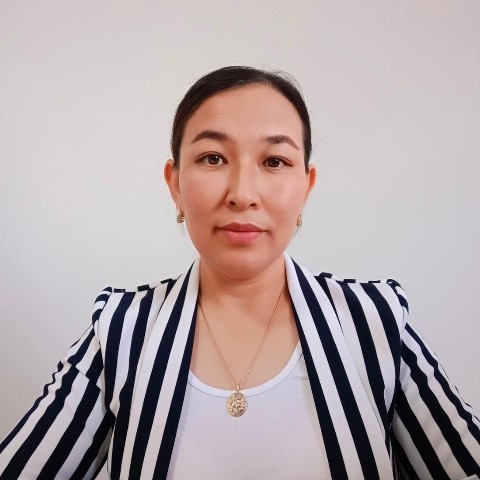
Nurbakyt Gulmira
Lecturer
The Department of «Biochemical engineering»
Master of science
email: gumi-nur@mail.ru




From 09/01/2011 to 08/31/2013 he worked as a physics teacher at school-lyceum No. 119 of the Auezov district of Almaty.
From 09/01/2013 to 08/31/2014 he worked as a laboratory assistant at the Department of Theoretical and Nuclear Physics of the Faculty of Physics and Technology of KazNU. al-Farabi.
From 09/01/2014 to 08/31/2015 he worked as an assistant at the Department of Theoretical and Nuclear Physics of the Faculty of Physics and Technology of KazNU. al-Farabi.
From 09/01/2015 to 08/31/2018 he worked as a teacher at the Department of Theoretical and Nuclear Physics of the Faculty of Physics and Technology of KazNU. al-Farabi.
From 09/01/2016 to 08/31/2018 - worked as a physics teacher in grades 10-11 at the profile school of the Kazakh National University. al-Farabi.
From 09/01/2018 to 08/31/2022 he worked as a senior lecturer in the Department of Theoretical and Nuclear Physics of the Faculty of Physics and Technology of KazNU. al-Farabi.
From 09/01/2022 to the present, he worked as a teacher at the Department of Natural Sciences of the Kazakhstan Engineering-Technolgy University.
- . .
- Kazakh National University named after al-Farabi. Bachelor "5B060500 - Nuclear physics".
2010 - 2012 Kazakh National University named after al-Farabi. Master "6M060500 - Nuclear physics".
2018 - 2021 Kazakh National University named after al-Farabi. "6D061100-Physics and astronomy" PhD.
Publications
- ARTICLES
- Boshkayev K., Quevedo H., Nurbakyt G., Malybayev A., Urazalina A. The Erez–Rosen Solution versus the Hartle–Thorne Solution // Symmetry Volume 11, p.1324, 2019. (SCOPUS Scope (Q2), Impact Factor:2.51 )
- K. Boshkayev, A. Malybayev , H. Quevedo, G. Nurbakyt , A. Taukenova, A. Urazalina . The correspondence of the Erez-Rosen solution with the Hartle-Thorne solution in the limiting case of ~Q and ~M2 // ISSN 1991-346X, News of the National Academy of science of the Republic of Kazakhstan: Physico-Mathematical Series, ISSN 1991-346Х https://doi.org/10.32014/2020.2518-1726.78 Volume 5, Number 333 (2020), P19 – 27
- Kuantay Boshkayev, Gulmira Nurbakyt, Hernando Quevedo, Gulnara Suliyeva, Aliya Taukenova, Abylaikhan Tlemissov, Zhanerke Tlemissova, Ainur Urazalina and Zdenˇek Stuchl´ık, “Adiabatic theory in Kerr spacetimes” // General Relativity and Quantum Cosmology //Cornel university arXiv:2207.07899, https://doi.org/10.48550/arXiv.2207.07899 2022
- G. B. Suliyeva, K. Boshkayev, G. Nurbakyt, H. Quevedo, A. S. Taukenova, A. T. Tlemissov, Zh. A. Tlemissova, A. Urazalina, “Adiabatic theory of motion of bodies in the Hartle-Thorne spacetime”// Vol 13 No 1 (2022): International Journal of Mathematics and Physics , DOI: https://doi.org/10.26577/ijmph.2022.v13.i1.09
- ABSTRACT AT THE FARABI ALEMI INTERNATIONAL CONFERENCE
- Boshkayev K.A., Nurbakyt G., «Correspondence of the Erez-Rosen metric with the q-metric», p. 11, 2019.
- Нұрбақыт Г. Қонысбаев Т., Курманов Е. “Квазипериодты тербелістер арқылы шағын нысандардың негізгі параметрлерін анықтау»
- ABSTRACT AT THE TAKIBAYEV INTERNATIONAL CONFERENCE
- Boshkayev K.A.,Zhumakhanova G., Nurbakyt G., «Erez-Rosen metric versus q-metric», p.18, 2019